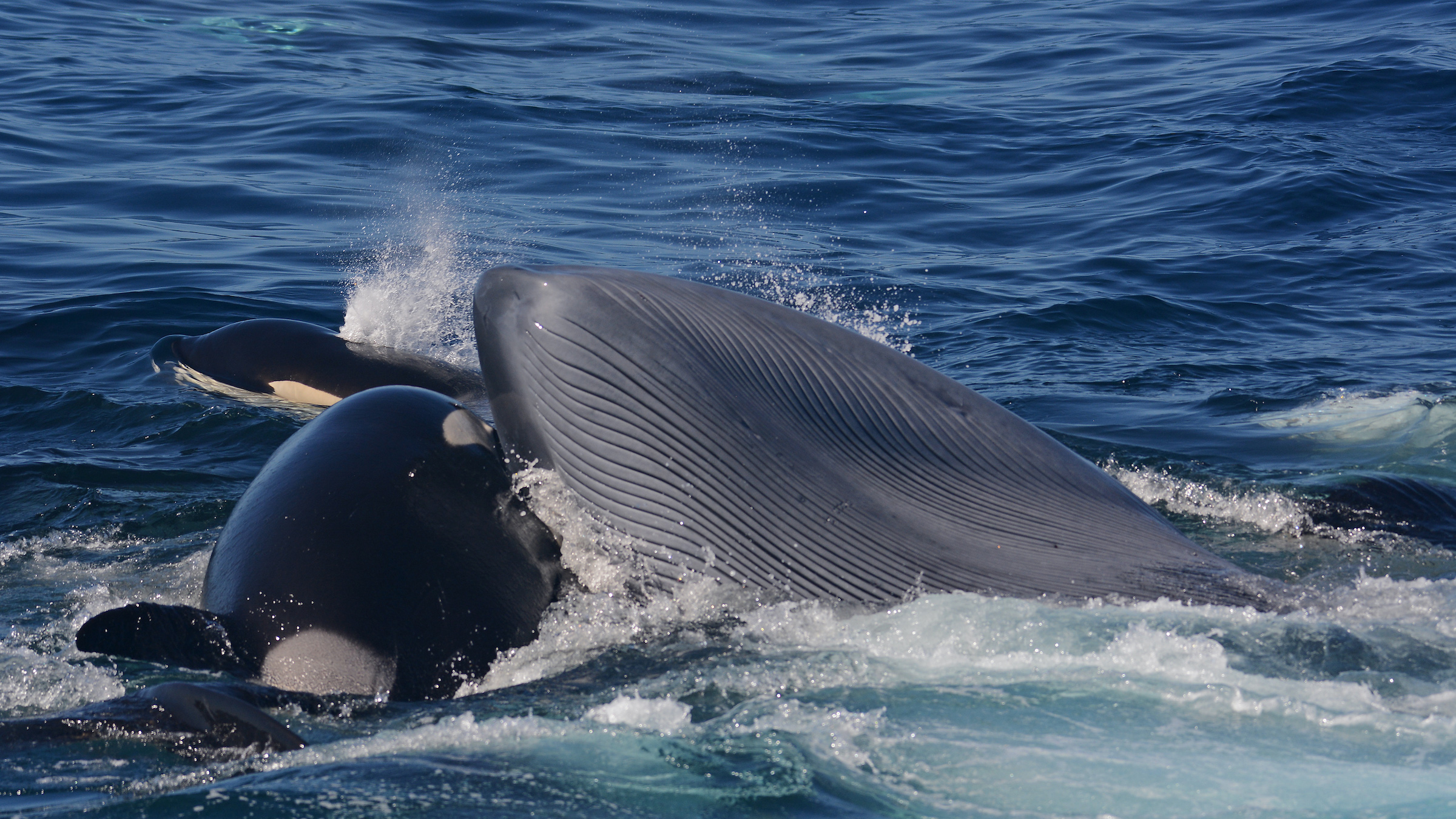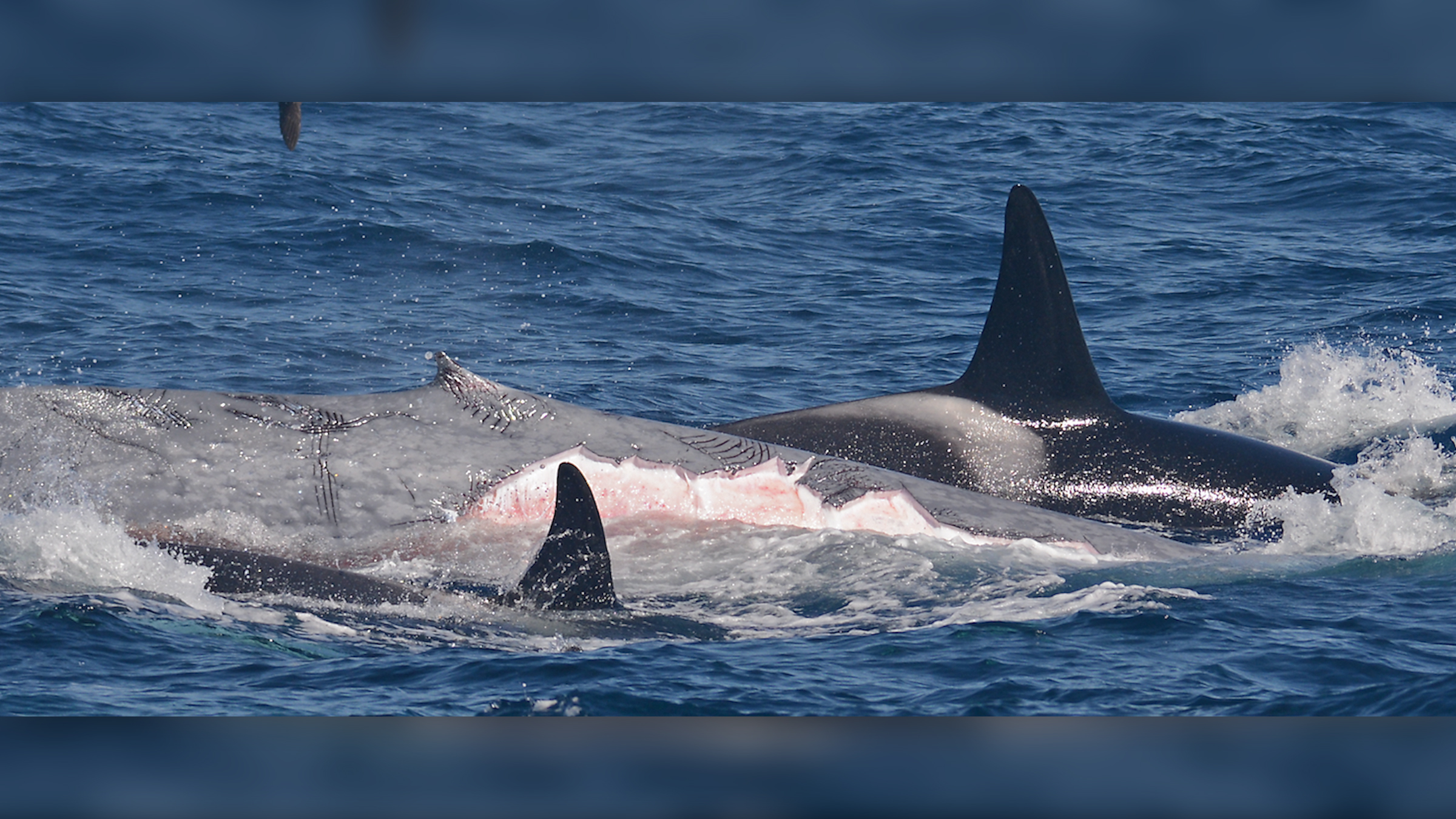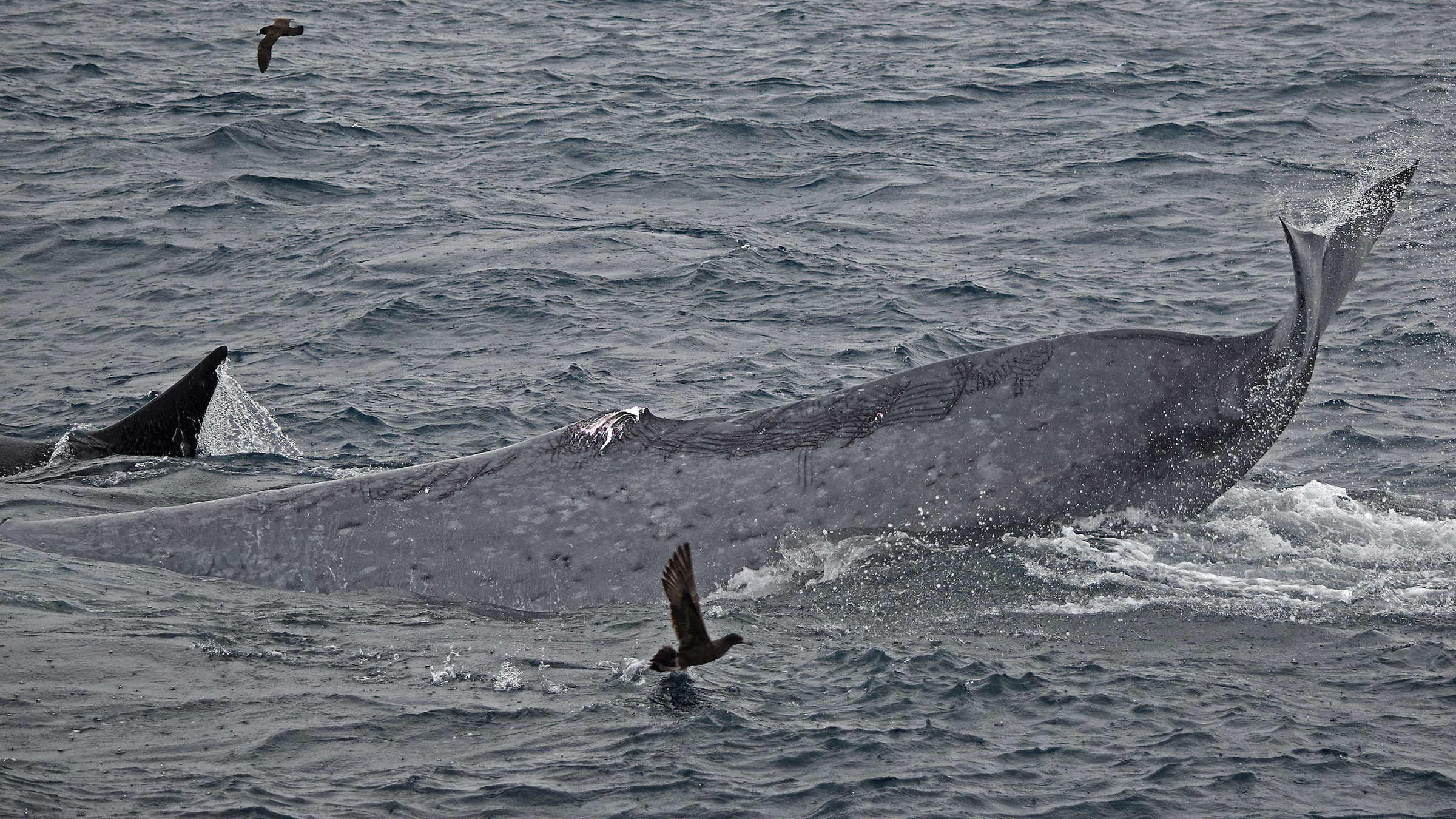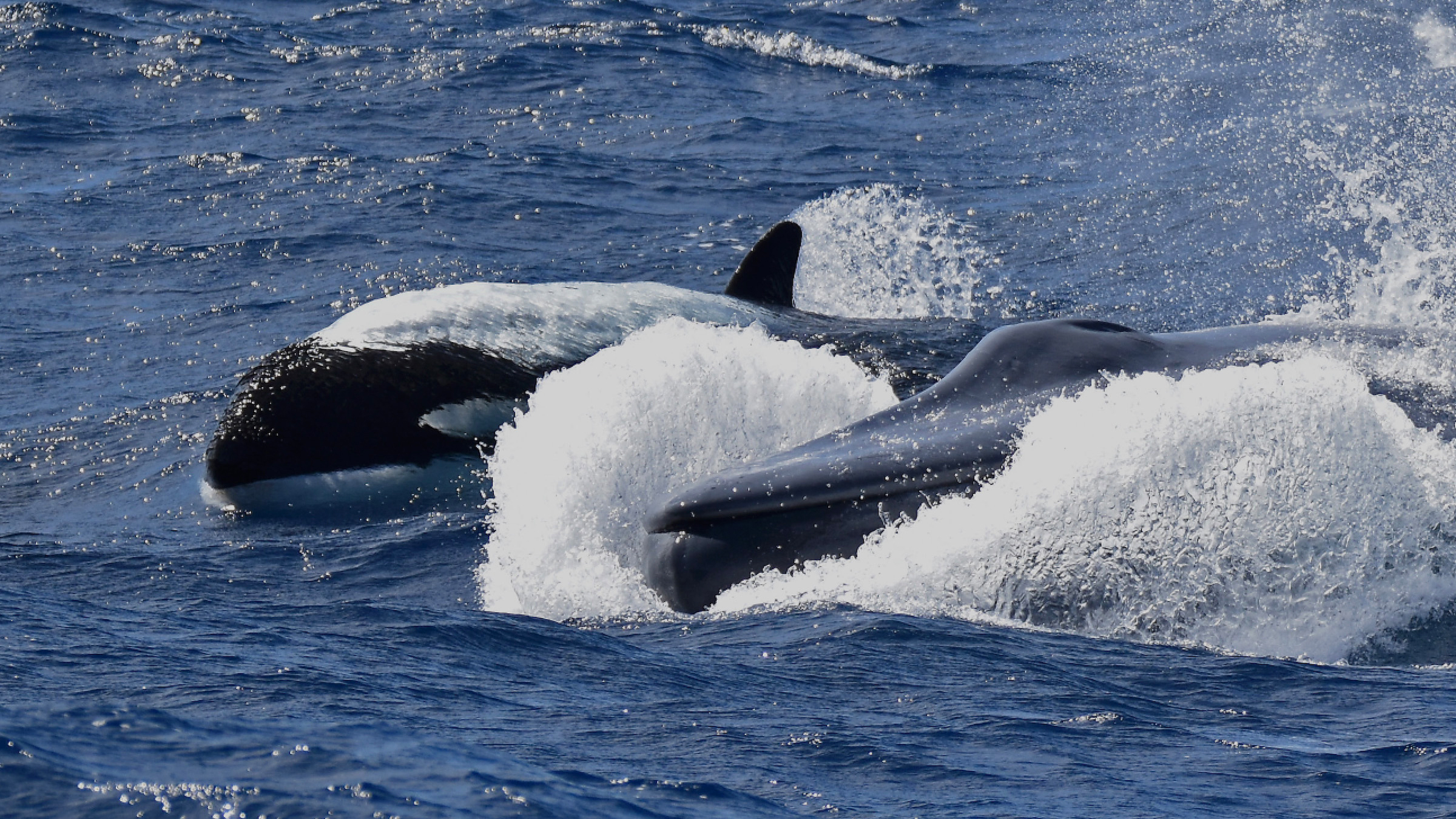Killer whales spotted for the first time killing blue whales
Three hunting episodes have been documented Down Under.

Gangs of killer whales have been spotted chasing, biting, suffocating and then devouring the largest creature on the planet: the blue whale.
Researchers documented these orcas, also called killer whales (Orcinus orca), taking down blue whales (Balaenoptera musculus) on three separate occasions off the southwestern coast of Australia between 2019 and 2021. Each episode included between 50 and 75 killer whales, and more than a dozen of these orcas took part in all three attacks, according to the study, published online Jan. 21 in the journal Marine Mammal Science. The takedowns seemed particularly brutal, with the orcas jumping on the blue whale's blowhole, dragging it underwater and, on one occasion, snacking on the live whale's tongue.
"These killer whales, they work together a lot and there are a lot of killer whales," study senior researcher Robert Pitman, a marine ecologist at the Marine Mammal Institute at Oregon State University, told Live Science. "That's probably the reason for their success down there."
Related: Photos: Orcas are chowing down on great-white-shark organs
The three attacks raise the question: Why haven't humans seen such grisly attacks before? The answer may be twofold: the low number of blue whales and the skills of the killer whales hunting them, Pitman said. Blue whales are still recovering from their near extinction from 19th and 20th-century whalers; even today, the species is endangered, according to the International Union for Conservation of Nature. But now, blue whale populations are increasing, including in southern Australia's waters, Pitman said.
It's likely that orcas preyed on blue whales before the giant cetacean's near extinction, Pitman said. But then, with so few blue whales to hunt, orcas likely focused on other prey. Soon enough, hunting blue whales presumably became a lost art in the orca community. "They probably lost those skills necessary to take down a large whale like that," Pitman said.
Now, it appears that orcas are noticing more blue whales and have figured out hunting strategies that lead to a big kill and feast, especially of the blue whale's tongue, the orcas' "preferred cut of meat," Pitman said.
Get the world’s most fascinating discoveries delivered straight to your inbox.
"It's like trying to stop a train"
Blue whales are hard to grab onto — their flippers can rest in grooves along their body; they have a small dorsal fin; and their tail moves up and down quickly, Pitman said. Moreover, they're fast swimmers. "When I was in Antarctica during whale surveys with the Japanese, the old whalers said they would chase blue whales at 12 knots [14 mph or 22 km/h] for 8 to 10 hours, and the whales would just swim off when [the whalers] were done," Pitman said. "They have incredible endurance."
Put another way, stopping a blue whale for a whaler or even an orca is "like trying to stop a train," he said. Even so, orcas have found ways to successfully attack blue whales.
The first attack was already underway when a research vessel encountered it on March 21, 2019. About a dozen killer whales attacking a 72-foot-long (22 meters) blue whale had left a severe wound with exposed bone on the whale's head and bite marks on its fins. "The blue whale was still attempting to flee its attackers and was slapping and swiping its tail," the researchers wrote in the study.
The attack continued, with orcas biting and ramming into the blue whale. One female orca even began eating its tongue, and the blue whale died soon after. After that, the number of orcas swelled to about 50 as they feasted, along with seabirds, on the whale's remains.
Related: 5 gruesome killer whale attacks





Tourists and scientists aboard whale-watching vessels witnessed the other two events. The second attack, on April 6, 2019, happened just 15 miles (25 kilometers) from the first. This time, a large group of killer whales of all ages was seen attacking a 39-foot-long (12 m) blue whale calf or pygmy that was roughly twice the length of the orcas. "Although still alive, large chunks of skin and blubber were missing from behind the blue whale's head and along its body," and it suffered from bite and tooth-rake marks, too, the researchers wrote in the study.
Whenever the whale tried to dive down to escape, the orcas pushed it up toward the surface; then other orcas would swim onto its head and blowhole, so it couldn't breathe, and push it down again. When the calf died, the orcas devoured its body, including its tongue.
This calf was "young enough that maybe it shouldn't have even been away from its mother," Pitman said. It's possible that the orcas separated the calf from its parent, "and she would have just left," Pitman said. "There's nothing she can do about it."
The third attack happened about two years later, on March 16, 2021, when killer whales charged at a blue whale. Whenever the blue whale — a 46-foot-long (14 m) individual, possibly a juvenile — stopped, maybe to rest, the orcas bit its mouth and head. After a substantial chase, the orcas pushed the blue whale underwater "and it was not seen alive again," the researchers wrote in the study.
"The attacks were all very similar — the killer whales were swimming along the side" and grabbed onto the blue whale's dorsal fin, flippers and tail as a way to slow it down, Pitman said. Then, the orcas would slide onto the whale's blow hole to prevent it from breathing and to wear it out.
"This event remains an astonishing encounter," study lead-researcher John Totterdell, a cetacean researcher at the Cetacean Research Centre (CETREC) in Western Australia who saw the first attack in 2019, told Live Science in an e-mail. "Till now, the marine mammal science world and the published literature mostly suggested killer whales were not capable of such feats."
These attacks may be providing a window to the past.
"Maybe we're finally getting to see a little bit of what the world looked like before we eliminated most of the large animals that swim in the sea," Pitman said.
Originally published on Live Science.

Laura is the managing editor at Live Science. She also runs the archaeology section and the Life's Little Mysteries series. Her work has appeared in The New York Times, Scholastic, Popular Science and Spectrum, a site on autism research. She has won multiple awards from the Society of Professional Journalists and the Washington Newspaper Publishers Association for her reporting at a weekly newspaper near Seattle. Laura holds a bachelor's degree in English literature and psychology from Washington University in St. Louis and a master's degree in science writing from NYU.



